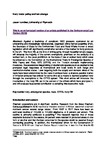Ivory trade: Poicy and law change
| dc.contributor.author | Lowther, Jason | |
| dc.date.accessioned | 2018-10-19T08:08:10Z | |
| dc.date.issued | 2018-12 | |
| dc.identifier.issn | 1461-4529 | |
| dc.identifier.issn | 1740-5564 | |
| dc.identifier.uri | http://hdl.handle.net/10026.1/12581 | |
| dc.description.abstract |
<jats:p> Against a backdrop of consistent NGO pressure, countered by an unrelenting and increasingly transnational organised crime-framed poaching effort, the Secretary of State for the Environment Food and Rural Affairs moved to enact legislation which will significantly curtail what remains of the market for ivory products in the UK. The Ivory Bill, at the time of writing going through its parliamentary stages, will sidestep the majority of the current exemptions, premised on the antiquity of a worked item, to the usual prohibition on the trade of raw or worked ivory which owes its existence to the Convention on the International Trade in Endangered Species of Wild Fauna and Flora 1973 (CITES) and the Treaty’s domestic implementing measures. The accelerated illegal killing of charismatic species such as elephants has prompted legal responses at international and local levels in both range and destination-market states. Laws targeting both the supply and demand sides of the trade have been undermined by the trade in antique ivory: a shadow, parallel market of imitation antiques has existed for some time to launder poached ivory through the exemptions to the CITES system. This short article will introduce the mechanics of the Ivory Bill, set in the context of the drivers which have prompted it, and will evaluate its potential contribution to curtailing this destructive trade. </jats:p> | |
| dc.format.extent | 225-232 | |
| dc.language | en | |
| dc.language.iso | en | |
| dc.publisher | SAGE Publications | |
| dc.rights | Attribution-NonCommercial-ShareAlike 4.0 International | |
| dc.rights | Attribution-NonCommercial-ShareAlike 4.0 International | |
| dc.rights | Attribution-NonCommercial-ShareAlike 4.0 International | |
| dc.rights | Attribution-NonCommercial-ShareAlike 4.0 International | |
| dc.rights | Attribution-NonCommercial-ShareAlike 4.0 International | |
| dc.rights | Attribution-NonCommercial-ShareAlike 4.0 International | |
| dc.rights.uri | http://creativecommons.org/licenses/by-nc-sa/4.0/ | |
| dc.rights.uri | http://creativecommons.org/licenses/by-nc-sa/4.0/ | |
| dc.rights.uri | http://creativecommons.org/licenses/by-nc-sa/4.0/ | |
| dc.rights.uri | http://creativecommons.org/licenses/by-nc-sa/4.0/ | |
| dc.rights.uri | http://creativecommons.org/licenses/by-nc-sa/4.0/ | |
| dc.rights.uri | http://creativecommons.org/licenses/by-nc-sa/4.0/ | |
| dc.subject | 16 Peace, Justice and Strong Institutions | |
| dc.title | Ivory trade: Poicy and law change | |
| dc.type | journal-article | |
| dc.type | Journal Article | |
| plymouth.issue | 4 | |
| plymouth.volume | 20 | |
| plymouth.publication-status | Published | |
| plymouth.journal | Environmental Law Review | |
| dc.identifier.doi | 10.1177/1461452918804939 | |
| plymouth.organisational-group | /Plymouth | |
| plymouth.organisational-group | /Plymouth/Faculty of Arts, Humanities and Business | |
| plymouth.organisational-group | /Plymouth/REF 2021 Researchers by UoA | |
| plymouth.organisational-group | /Plymouth/REF 2021 Researchers by UoA/UoA18 Law | |
| plymouth.organisational-group | /Plymouth/Research Groups | |
| plymouth.organisational-group | /Plymouth/Research Groups/Marine Institute | |
| plymouth.organisational-group | /Plymouth/Users by role | |
| plymouth.organisational-group | /Plymouth/Users by role/Academics | |
| dcterms.dateAccepted | 2018-08-21 | |
| dc.rights.embargodate | 2019-2-12 | |
| dc.identifier.eissn | 1740-5564 | |
| dc.rights.embargoperiod | Not known | |
| rioxxterms.versionofrecord | 10.1177/1461452918804939 | |
| rioxxterms.licenseref.uri | http://creativecommons.org/licenses/by-nc-sa/4.0/ | |
| rioxxterms.licenseref.startdate | 2018-12 | |
| rioxxterms.type | Journal Article/Review |



